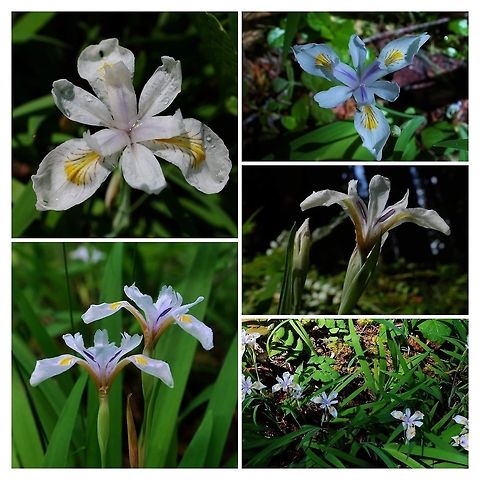
Appearance
It is similar in form to ''Iris cristata'', except that it is taller and larger.It has small, slender, cord-like, rhizomes, which are 10–15 mm in diameter. They have brown scale-like leaves on top of the rhizome. The shallow rooted, creeping and spreading rhizomes, create loose colonies around 30 cm wide.
It has deciduous, narrow, pale green, or dark green, basal leaves. They are sword-shaped, they can grow up to between 30–35 cm long and 1–1.5 cm wide. They are fan-like, with brown membranous edges. The leaves are taller than the stems.
It has slender, stems that can grow up to between 30–35 cm tall.
It has 2–3 branches. The pedicel are 0.4–1 cm long but they do not carry the flower clear of spathes.
The stems have several spathes , that are 2–3 cm long and 5 mm wide, and scarious .
The stems hold 1 flower , in late spring, between April and May.
The flowers are 3–5 cm in diameter, and come in shades of white, pale blue, or pale lilac.
It has 2 pairs of petals, 3 large sepals , known as the 'falls' and 3 inner, smaller petals long, with violet, blue or purple veins. In the centre is a yellow signal area and a low yellow or golden crest with undissected ridge.
The erect standards are oblanceolate-spatulate, shorter than the falls, and notched at tip.
It has a 3 cm long, funnel-form perianth tube, triangular-acuminate stigmas and a 0.4–0.7 cm long, elliptical ovary.
It has 1.8 cm long styles, that do not have notched lobes.
In propagation, the pollen tubes of ''Iris tenax'' reach the ''Iris tenuis'' ovules in 30 hours, whereas the pollen tubes of ''Iris tenuis'' require 50 hours to reach the ''Iris tenax'' ovules.
After the iris has flowered, it produces an globose, or ovoid seed capsule, which is 0.9–1.5 cm long and 1.2 cm wide.
Inside are D shaped, pale brown, pitted seeds, with a whitish raphe .
Distribution
It is native to north western USA.Status
''Iris tenuis'' along with ''Aster gormanii'' , douglasia laeviagata var. laevigata, ''Isopyrum hallii'', ''lilium washingtonianum'', ''Pleuricospora fimbriolata'' and ''Sullivantia oregana'' are all ''sensitive'' species recorded with the Table Rock Wilderness in Oregon.It grows in Mount Hood National Forest, Oregon.
Habitat
It is native to north western USA.It grows in the open wooded slopes, and along shaded stream banks.It is found underneath the Douglas fir , and other shrub undergrowth in large colonies, in moist leafy soils.
Defense
Like many other irises, most parts of the plant are poisonous , if mistakenly ingested can cause stomach pains and vomiting. Also handling the plant may cause a skin irritation or an allergic reaction.References:
Some text fragments are auto parsed from Wikipedia.